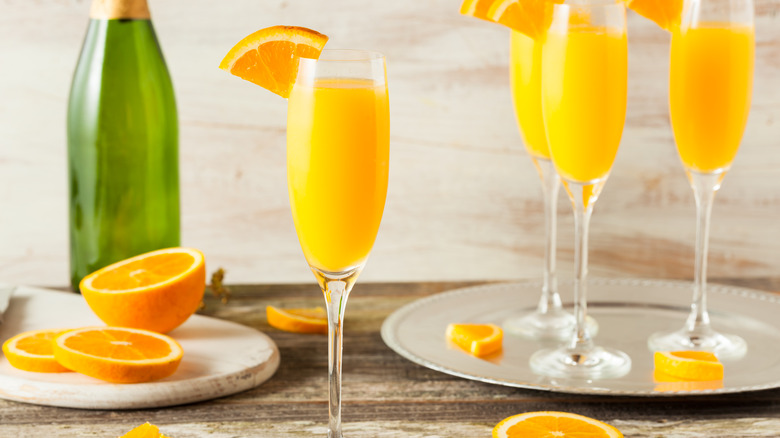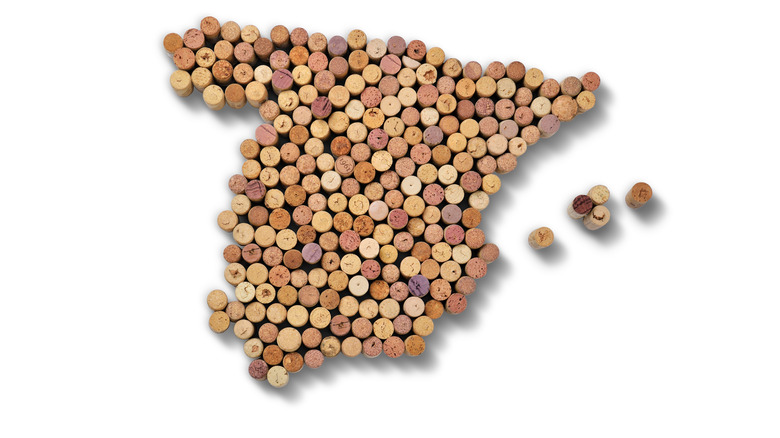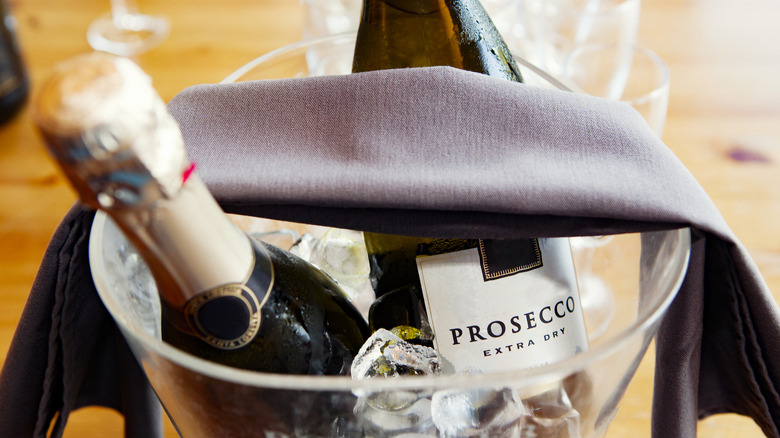What You Can Use In Place Of Champagne For Mimosas
In a world full of cocktail controversies — shaken or stirred, bourbon or rye — there's perhaps no cocktail that's simpler and more elegant than the mimosa. Traditionally made with equal parts Champagne and orange juice and served in a flute, the mimosa is foolproof, versatile, and inherently celebratory. If you want to get fancy or bump up the alcohol content, you can throw in a little orange liqueur like triple sec or Gran Marnier, but the basic cocktail requires just two ingredients to start the party, perfect by the glass or by the pitcher.
If the mimosa had a drawback, it would be the fact that one of the two ingredients is downright expensive. BevAlc Insights points out that in 2022, the average price per bottle of real-deal Champagne is $50. That's a lot of money to pour into a pitcher and serve to a crowd. Champagne is expensive for a number of reasons, among them the fact that the Champagne region isn't very large, and it takes a long time to make the wine; the Comité Champagne explains all Champagne must spend at least 15 months in bottle before release, and some are aged for up to 10 years. So, if you want to make your mimosas a bit less expensive, here is what you can use instead.
Spanish Cava is a great choice for mimosas
Different country, different grape varieties, and typically a much lower price point ... other than that, Cava and Champagne are practically the same thing. While Champagne is typically made from chardonnay, pinot noir, and pinot meunier, Cava, the sparkling wine made in northeastern Spain, is usually made from grape varieties most people aren't as familiar with. Food & Wine explains most Cava is made from macabeo, parallada, and xarello, though garnacha, monastrell, chardonnay, and pinot noir find their way into blends as well. For Cava, like Champagne, the magic happens in the bottle. The secondary fermentation that imparts effervescence to the wine happens in each individual bottle, a process known as the traditional method.
Most Cavas are significantly less expensive than Champagne; on Wine Searcher's list of best values for Cava, most of the bottles are in the $9-$20 range. And as for flavor, Cava, among the inexpensive Champagne alternatives, is one of the most similar to the French bubbly. Like Champagne, Cava must be aged before its release, a minimum of nine months, but often more, according to Somm Conn. Food & Wine points out that you'll get an earthy, toasty mid-palate, brightened by aromatic notes of apple and pear. If you want your mimosa on the drier side, most similar to those made from Champagne, Cava is the perfect choice.
Italian Prosecco makes lovely mimosas as well
While Cava and Champagne share similar production methods, Prosecco is quite different, and the process yields a wine with quite a distinct flavor profile. Most Prosecco begins with an entirely different grape as well, according to Casa Prosecco, a variety called glera. Though small amounts of other grape varieties are permitted in Prosecco, glera reigns supreme. And the process for getting those delightful bubbles into Prosecco is called the charmat method, meaning the entire tank of wine is carbonated, then the bottles are filled with the already fizzy wine.
Because Prosecco doesn't rely on aging in the bottle to produce the desired carbonation, Prosecco remains more youthful in its flavor profile, in general, skewing a bit sweeter and fruitier than either Champagne or Cava, according to Food & Wine. And given that VinePair has a list of 10 delicious Proseccos, all of which come in under $20, Prosecco is an ideal choice for those who prefer their mimosa on the sweeter, fruitier side. Just as you probably wouldn't cook with a $100 bottle of wine, there's no great need to throw down $50 for a bottle of Champagne for mimosas, particularly if you're making them by the pitcher. Prosecco and Cava are perfect for your celebratory cocktail.


